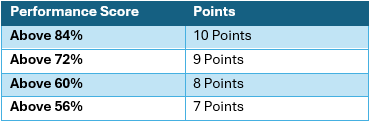REGCLR1 measures the improvement in pain level of patients with a diagnosis of Heel Pain after an intervention.
On the initial visit, you need to document their pain level on a standard 1-10 pain scale. You must provide some type of intervention.
Intervention is something that you have done for the patient to reduce the pain level. This includes but is not limited to:
- • Dispensing of custom orthotics
- • Dispensing of prefabricated orthotics
- • Injections for heel pain
- • Dispensing of night splints
- • Education on stretching
- • Providing physical therapy
- • Change of shoe gear
- • Surgery
The patient must return for a subsequent visit, and you need to document their pain scale on a standard 1-10 pain scale.
Performance Met
To meet the measure, the pain must have decreased significantly. Significantly is defined as equal to or less than 50% of the initial value. If the initial pain value was 8, the most recent pain value must be 4 or less to count for this measure.
The pain does not need to decrease significantly on their next visit. It can be in some future visit. Every visit you must document the updated pain scale to demonstrate that the pain has decreased significantly between the first and most recent visit.
What if a patient comes in a lot of pain, I treat the patient, the patient gets 100% better and they don’t return?
There are two options. If a patient does not return for a second visit, they are excluded from the measure. Alternatively, you can call the patient. Over the phone, the patient says that their pain has disappeared. You document that their pain level is 1 and they qualify to meet the measure. Document the call as a telehealth visit and bill as telehealth with appropriate documentation. This also applies if a patient calls to cancel because they are better. This documentation in the patient’s chart does not need to be noted by the doctor. It can be noted by the MA, receptionist or whomever speaks to the patient on the phone.
Performance Not Met
All patients that do not report a decrease in pain of at least 50% count against you.
It also counts against you if you do not document a pain scale.
Exclusions
There are two exclusions for this measure: patients who were prescribed opioids for pain and patients who did not return for a second visit after being provided an intervention.
The measure is looking for pain to improve, not to be masked by opioids. Therefore patients that are prescribed opioids are excluded from this measure and neither count for nor against you.
The measure is looking for a change of pain level. Therefore, if there is no subsequent visit (including telehealth), there is no second pain level to compare against the initial pain level.
Points
The benchmarks for this measure are very favorable

To get 10 points, you only need 85% of your patients to get better. You don’t need to be perfect to score well on this measure, you just need to be pretty good.
This is a measure that relates to treatment that podiatrists provide all of the time. The only additional burden on documentation is to document the pain scale in the chart. And having the pain scale from each visit appear when treating your patient for heel pain can only help with treatment.
Our goal is to get 60/60 points in quality measures. You have to report on 6 measures. If you are a small practice, you get an additional 6 bonus points. By scoring an average of 9 on the six measures and adding the 6 points, you get the full 60 points.
As a podiatrist, this is a great measure to report on. It is podiatry specific and easy to score well.
Contact Registry Clearinghouse at info@registryclearinghouse.com or schedule a meeting to learn more about how Registry Clearinghouse can help you.



Read Comments